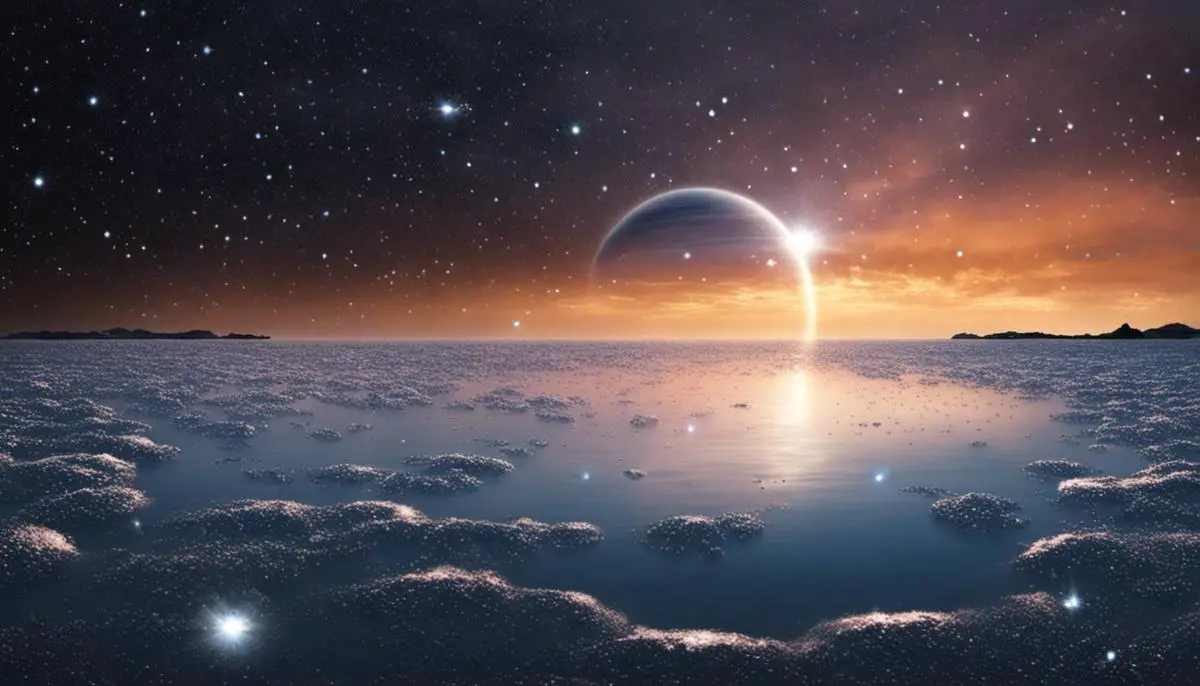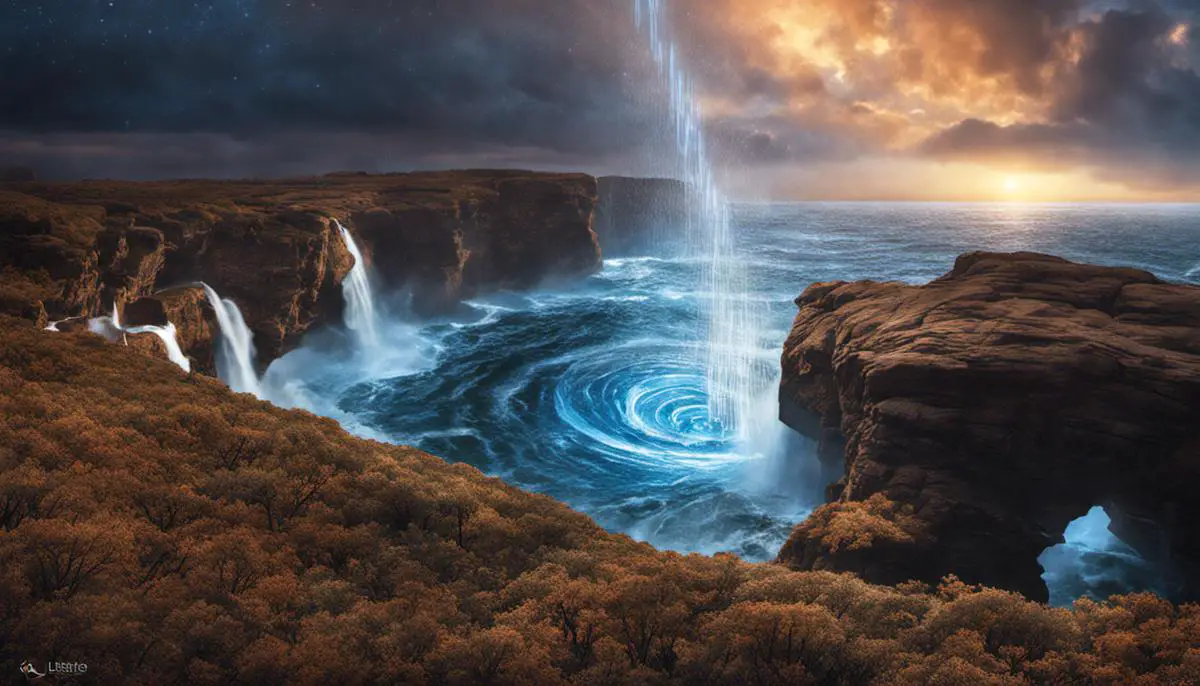As the solar system’s distant blue-green planet, Neptune nurtures secrets beneath its tempestuous, cloud-swirling exterior that continue to astonish scientists. Among the most fascinating is the discovery of a phenomenon quite alien to our conventional understanding: a ‘rain’ of diamonds. With a striking array of methane and other hydrocarbons in Neptune’s atmosphere, the planet’s high-pressure and high-temperature conditions might possibly create an environment for diamond precipitation. This journey into Neptune’s mysterious diamond rain delves into the atmospheric conditions that provide the setting, the step-by-step process of diamond formation, the pivotal role of science in uncovering this phenomenon, and the far-reaching implications it has for our understanding of cosmic structures and dynamics.
The atmospheric conditions of Neptune
Unveiling Neptune: Discovering the Phenomenon of Diamond Rain
Neptune, the eighth and farthest known planet from the sun in the solar system, harbors an enigmatic and unique climate that continues to captivate the scientific community since its discovery. Among its towering clouds and fierce winds, there is an occurrence that is seemingly more science fiction than fact – Diamond Rain.
While the concept of diamond rain may sound otherworldly and improbable, a deep understanding of Neptune’s climatic and atmospheric conditions provides substantial evidence for this hypothesis. Atmospheric conditions on Neptune, dominated by intense pressure and temperature gradients, create an environment conducive to the formation of diamonds, an endeavor that on our home planet requires exposure to high temperatures and pressures over a significantly longer timeframe.
Neptune’s atmosphere, primarily composed of hydrogen and helium along with traces of methane, sets up a primordial cocktail where the tantalizing possibility of diamond formation resides. The presence of methane, a compound of carbon and hydrogen, is crucial as carbon is the key element in the formation of diamonds.
Within the depths of Neptune’s atmosphere, extreme pressure, exceeding millions of atmospheres, and escalating temperatures, up to about 9300 degrees Fahrenheit, act upon this methane abundance. Under these conditions, methane molecules are disintegrated into their fundamental elements: hydrogen and carbon. The intense pressure then condenses these carbon atoms into crystalline structures, giving birth to what we understand to be microscopic diamonds.
These nano-diamonds, now denser than the surrounding materials, descend further into Neptune’s depths due to gravity, literally “raining” down into the planet, as predicted by the theory. The base of Neptune’s unusual atmospheric conditions is an ocean of liquid diamond, with solid ‘diamond-bergs’ possibly floating atop it – an astonishing manifestation of planetary physics.
Research substantiating the possibility of diamond rain on Neptune is based on experimental laboratory simulations that recreate the extreme conditions within the planet’s interior. Coupled with theoretical calculations, there’s growing consensus within the scientific community towards the validity of this fascinating phenomenological event.
While little is known about Neptune’s elusive interior, our understanding of the planet’s unique weather phenomena is steadily growing, galvanized by advancements in astronomical observation and computational simulation technologies. Diamond rain on Neptune showcases the vast and varied existence of extraordinary phenomena occurring throughout our Universe.
The study of Neptune’s diamond rain sheds light not only on the fascinating atmospheric conditions of this distant gas giant but also opens new discoveries in understanding high-pressure physics, phase transitions, and nuclear astrophysics. The insight into exotic but considerable resources of extraterrestrial environments, such as Neptune’s hypothesized diamond rain, also kindles a flame of speculation regarding humankind’s future endeavors in space exploration and resource exploitation.
Undeniably, the unique weather conditions exhibited on Neptune pose intriguing, potentially unending questions about our universe that scientists eagerly yearn to answer. It stands as evidence that even the most fantastical notions of science fiction have a peculiar habit of emerging as scientific truths waiting to be discovered in the endless expanses of our cosmic neighborhood.

The process of diamond precipitation
Delving into the Diamond Deluge: A Scientific Exploration of Neptune’s Sparkling Rain
Understanding explicit mechanisms such as the formation and “rain” of diamonds within Neptune’s environment extends beyond the realm of sheer curiosity. This remarkable phenomenon encapsulates the essence of planetary science, requiring us to challenge the paradigms of our knowledge and push the boundaries of our scientific explorations.
To uncover the mysteries of the cosmos, we rely heavily on the multifaceted nature of scientific inquiry, which necessitates meticulous observations, mathematical precision, and technological prowess. In the case of Neptune’s diamond rain, the labyrinth has unraveled through a combination of spectroscopic investigations, astrophysical simulations, and laboratory recreations of the Neptunian environment.
Spectroscopy, predicated on the analysis of light and its interaction with matter, provides valuable insights into Neptune’s upper atmosphere and its concentration of hydrocarbons, with evidence pointing towards abundant methane. Through calculation, we can infer that the high temperatures (about 6,700 Kelvin) and severe pressures (over 11 million pounds per square inch) found deep within the gaseous exterior potentially drive the formation of these precious crystals.
Furthering these findings, laboratory experiments replicating these crushing pressures and searing temperatures underscored the plausibility of diamond formation. Employing exquisite techniques, such as the creation of shockwaves within substances to instigate high-pressure conditions, scientists have successively transformed hydrocarbon compounds into nanodiamonds. Importantly, this cubic crystalline formation mirrors the atomic structure of diamonds naturally formed on Earth, bolstering the hypothesis of diamond precipitation on Neptune.
Moreover, in the realm of computational astrophysics, digital simulations offer critical insights into the pathway methane might undergo within Neptune’s high-pressure regimes, from breaking down into simple hydrocarbons to re-assembling into diamond structures. In this hypothesis, diamonds precipitate through the dense atmosphere, ultimately sinking into deeper, higher-pressure layers due to their immense density.
This seamless coupling of theoretical calculations, earthbound laboratory testing, and astrophysical simulations illustrates the deeper interdisciplinarity within planetary sciences. Their confluence has propelled novel understandings not just of celestial phenomena, like Neptune’s diamond rain, but also of high-pressure physics and phase transitions.
In contemplating the far-reaching implications of these studies, it’s not unreasonable to envisage its potential impact on future space exploration endeavors. The prospect of alien worlds stowing diamond reservoirs could trigger dramatic advances in the quest for cosmic resources, altering our approach to interstellar travel and mining operations. However, one should tread cautiously along this road. As the interstellar journey is replete with unknowns and challenges, so too is the practical extraction of these resources. It remains a tantalizing, yet highly complex prospect.
Neptune’s diamond rain juxtaposes the realms of reality and imagination, as we discern the secrets of the universe with a balanced blend of science and speculation. This peculiar precipitation punctuates our need for persistent exploration and research, echoing the words of Carl Sagan when he said, “Somewhere, something incredible is waiting to be known.” Identifying and unraveling these mysteries necessitates not just a keen eye for observation but also an unrestrained passion for the unknown. So it is, Neptune’s diamond falls—a scientific riddle nestled within the firmament, continuously inspiring and challenging the human quest for knowledge.

The discovery and evidence
Continuing the exploration of Neptune’s ostentatious diamond rain conundrum, it seems pertinent to delve into the specific research that supports this phenomenon.
A crucial piece of evidence comes from NASA’s mission Voyager 2, which allowed scientists to keenly analyze Neptune’s atmosphere. Scientific instruments, capable of detecting methane, indicated a surprising abundance of this gas. The presence of methane, coupled with high temperatures and severe pressure, propose excellent conditions for diamond formation.
This data aided in the execution of various laboratory experiments, essential in bolstering the plausibility of diamond rain. Most notably, the study by Kraus et al., emulated Neptune’s interior environment using high-powered optical lasers to induce pressures up to 150 GPa onto a methane-rich substance. This resulted in the formation of diamond structures, providing invaluable experimental evidence supporting the diamond rain theory.
Similarly, computational astrophysics has dramatically advanced our understanding in this field. Complex simulations present an accessible method to understand methane transformation under extreme conditions. The research by Wahl et al., utilized well-tested hydrodynamic codes to numerically model Neptune’s interior, proving a conjecture of a diamond-seeding base layer.
While these findings are thrilling, the field of planetary science requires an interdisciplinary approach. Melding experimental physics, computational modeling, and astrophysical observations refines our understanding of planets and their respective idiosyncrasies. This collaborative work has illuminated possibilities for carbon-based chemistry in a broader range of exoplanets.
Moreover, the possibility of diamond rain judiciously stirs an economic interest: space resource extraction. While technologically currently out of reach and ethically contentious, the potential bounty from Neptune—a celestial jewel rich with diamonds—reiterates the sector’s potential profitability. One must however duly note, the immense challenges and complexities involved in such extraterrestrial endeavors.
In closing, it is imperative to acknowledge the strategic balancing act between science and speculation. While the evidence supporting diamond rain on Neptune is compelling, it is not yet definitive. The universe unceasingly guards its secrets, obliging the scientists to embark on a never-ending quest for knowledge. After all, it is the perpetual thirst for understanding that propels humanity outwards to explore, learn, and discover the cosmic neighborhood above and beyond.

The implications and significance of diamond rain
Furthering our understanding, recent diamond findings not only illuminate more about Neptune, but they also bring perspective to the planetary science as a whole. These discoveries compel us to query our fundamental understanding of conditions within giant planets and question our perspective on planetary formation, weather systems, and even material science.
The intriguing concept of diamond rain on Neptune helps to elucidate the extreme practices of nature in different planetary environments. More than merely the glamour of diamonds, it suggests a completely diverse weather system operating under incomprehensible pressure and temperature conditions. Understanding these dynamics is essential in unraveling the broader narrative of our universe and perhaps even the origins of life itself.
It is through studying these unique phenomena that we hone our understanding of several scientific fields. Specifically, advancements in high-pressure physics have direct implications in nuclear astrophysics, planetary sciences, and even material sciences.
Diving beyond the confines of Neptune, these diamond revelations are significant to our understanding of other gas giants. Jupiter, Saturn, Uranus, and potentially exoplanets beyond our solar system, all share conditions conducive to this distinct downpour. The applications in studying these planets become even more profound when we consider not only the gas giants within our solar system but also the potential millions of similarly structured exoplanets in the cosmos.
Considering a broader universal viewpoint, Neptune’s diamond rain changes our understanding of how different planets recycle carbon. Fundamentally altering our grasp of chemical dynamics within these planetary atmospheres, the likeness of a carbon cycle similar to Earth’s alters dramatically. This amended perspective incites further research into planetary atmospheres and geological processes.
Examining diamond rain also takes us into the realm of potential cosmic resource exploitation. While this may seem farfetched now, the potential abundance of diamonds within Neptune and similar planets could revolutionize our understanding of resource availability in the universe. However, such an endeavor will present monumental challenges in engineering, logistics, and ethics that could stimulate major advancements in those respective fields.
Finally, the excitement generated by these surprising findings underscores the perennial human drive to uncover the universe’s secrets— the joy of the known discovering the unknown, catalyzing advancements in technology and science itself. The exploration of Neptune’s diamond rain subtly reminds us that the quest for understanding our universe is far from over.
In conclusion, these diamond discoveries on Neptune and elsewhere signify much more than unforeseen weather patterns or potential mining operations. They represent the essence of scientific exploration— taking us one step closer to piecing together the cosmic puzzle and further illuminating the profound complexity and beauty of our universe. As we continue to delve deeper into the celestial domain, each revelation expands our understanding and prompts even more probing questions, fueling human curiosity and the spirit of science for generations to come.

From the depths of Neptune’s intense interior emerges a masterpiece of cosmic chemistry – the diamond rain, a phenomenon as mesmerizing as it sounds. It provides critical insights into Neptune’s internal heat, structure, and vibrancy, thereby contributing to our broader understanding of planetary behaviors. Furthermore, the revelation of diamond precipitation challenges the confines of our knowledge, leading us to contemplate it as a conceivable occurrence on other celestial bodies with similar atmospheric conditions. This anomaly, thus of diamonds being formed and falling as rain thousands of miles beneath Neptune’s hostile surface, not only enriches our perspective on the dynamic planet itself but also enables us to view the universe under a new, dazzlingly variant, and ever-inquisitive lens.
![]()
